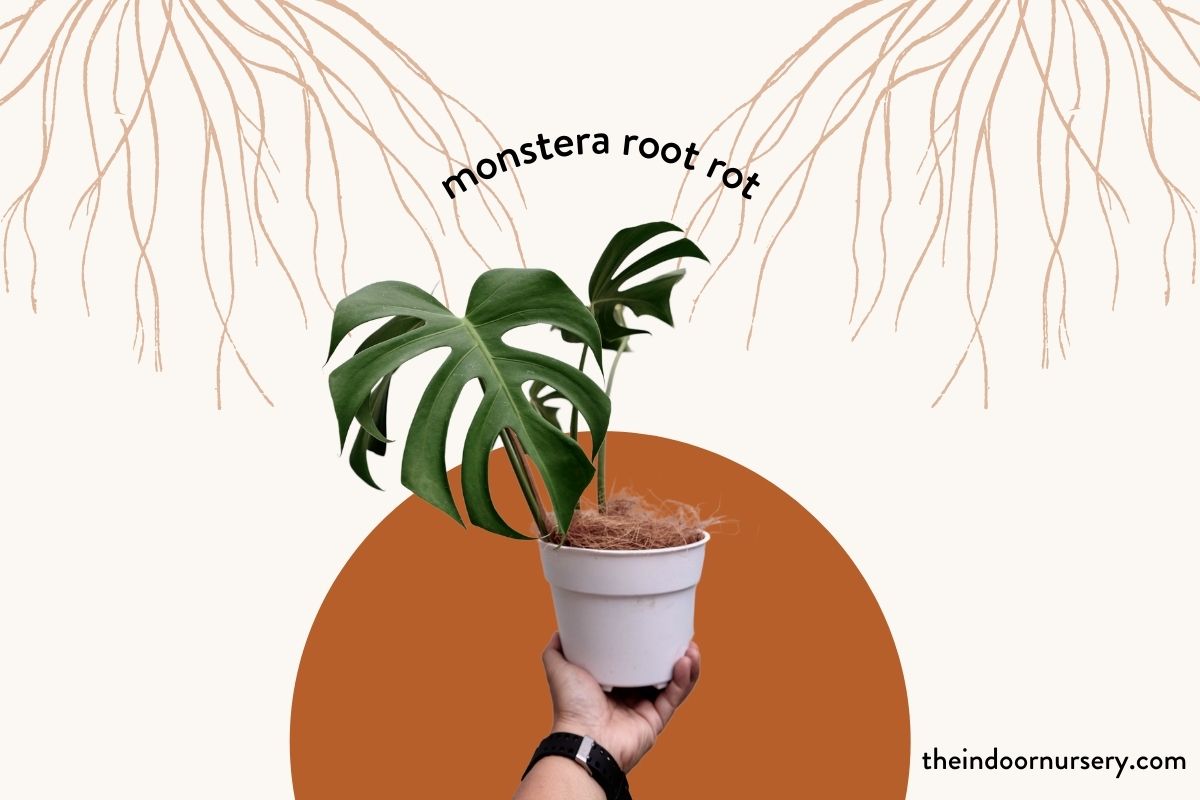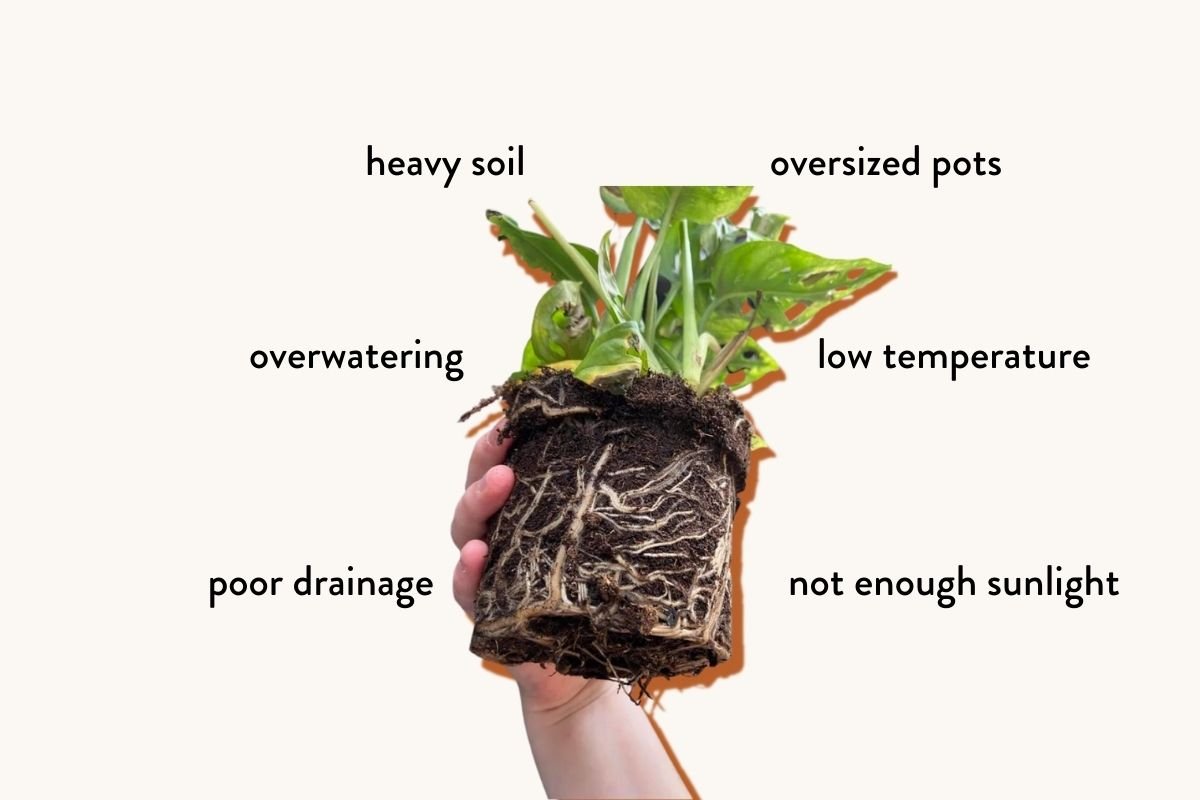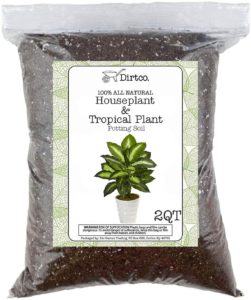Monstera deliciosa are gorgeous, tropical indoor plants that love humidity and warm temperatures. But what happens when the leaves of your plant start having brown spots and looking weak and sick? Unfortunately, Monstera root rot may be the culprit. 👎
Root rot is when your Monstera’s roots start to get mushy and brown due to sitting in stagnant water for too long. This is essentially a fungal infection, as root rot creates the perfect environment for fungus and bacteria to grow.
This fungal root rot smells bad and affects the entire plant.
Don’t worry though. Luckily, there are solutions and ways to treat Monstera root rot, as well as ways to prevent it from happening again once you notice the signs of root rot.
Root rot signs in a monstera plant
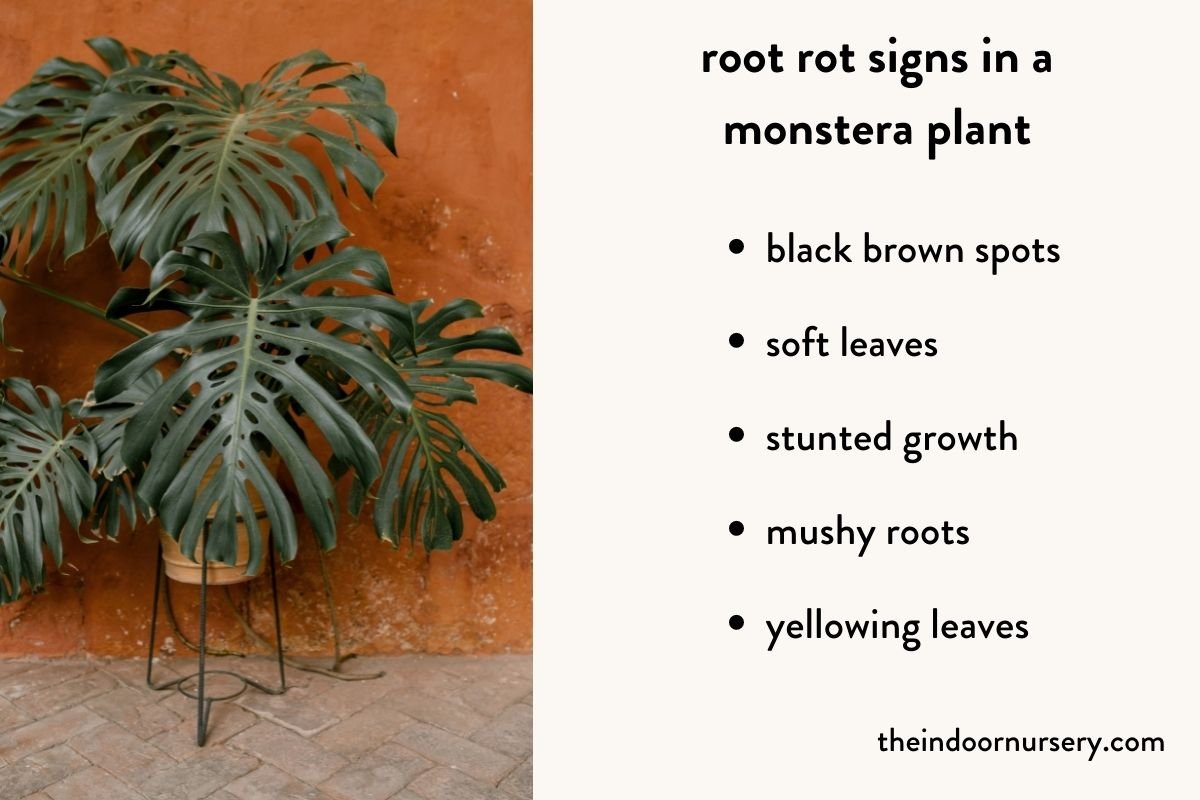
When there is too much soil moisture, the root system becomes oversaturated and waterlogged. The soggy soil will create an environment that permits disease and bacteria to thrive, which will create rotten, mushy roots. 🤮
This happens mainly when you have been overwatering your plant, or if the drainage hole in the pot gets blocked. Overwatering is when the soil is not able to dry out enough in between each time you water your plant, causing root rot. Some plants need a water schedule to make sure that you don’t overwater.
When there is too much water and excess soil moisture, it can suffocate the root system, which causes it to rot. If your Monstera’s root rot continues like this without treating, it can kill your entire plant.
You can save your Monstera plant and fix root rot by applying some simple treatments that will give your plant healthy roots again.
Here are some of the tell-tale Monstera root rot signs:
- Black brown spots. Black spots on the affected leaves are a sure sign of root rot. This is due to the pathogens and bacteria taking over the plant. You may also see a yellow hue surrounding the black spots.
- Soft leaves. If your Monstera’s leaves are soft or wilting, this is a sign of the plant receiving a lack of nutrients from the soil. This can be due to overwatering or the Monstera’s roots being rotten.
- Stunted growth. This sign is a little bit harder to diagnose, but just know Monstera plants are supposed to be thriving and growing during their growth season. If your plant is not growing at all, then you know there’s a problem, and it usually has more to do with the roots than the plant itself.
- Mushy roots. Mushy or smelly roots are usually a clear sign that your Monstera has root rot. If your plant is sitting in damp soil, you can gently pull on the roots to see if they are weak and breaking. Otherwise, if you are still unsure, you can dig a little bit into the soil and check the roots. you will be able to tell by a foul odor coming from the roots of your plant.
- Yellowing leaves. Foliage is a great mirror of what is happening internally with the plant. If the leaves are yellow or brown, then this is usually are sure sign of rotting roots.
What causes root rot in a Monstera plant?
- Overwatering. Overwatering is one of the biggest causes of root rot in a Monstera. you can easily know that you are overwatering when you are watering too frequently, or it’s not being drained properly. You can always tell by checking the moisture in the potting soil, and make sure to only water when the top part of the soil is dry.
- Poor drainage. Even if you have a solid watering schedule, water can get trapped at the bottom of your pot, which is why it is super important to have a well-draining pot. The lack of oxygen invites bacteria and other types of infections to thrive in the infected roots.
- heavy soil. The drainage issue could also be due to the soil not being loose enough. make sure you have a good potting soil and add something lighter like sand or perlite.
- Oversized pots. In a larger pot, the water takes longer to evaporate and the soil takes longer to dry. The best is a perfect-sized pot for your Monstera that allows the air to flow and your soil to dry properly.
- Low temperature. Monstera is a strong plant and not too affected by climate conditions, yes it can be affected when the temperature drops below 50 degrees Fahrenheit. The lower the temperature, the more likely the soil will become damp and soggy. This will increase the chances of the roots being infected.
- Not enough sunlight. If your Monstera is not getting enough light, then the chances of the soil drying will decrease. Monstera’s need about 5-8 hours of bright indirect light per day to thrive.
How to save a monstera after root rot
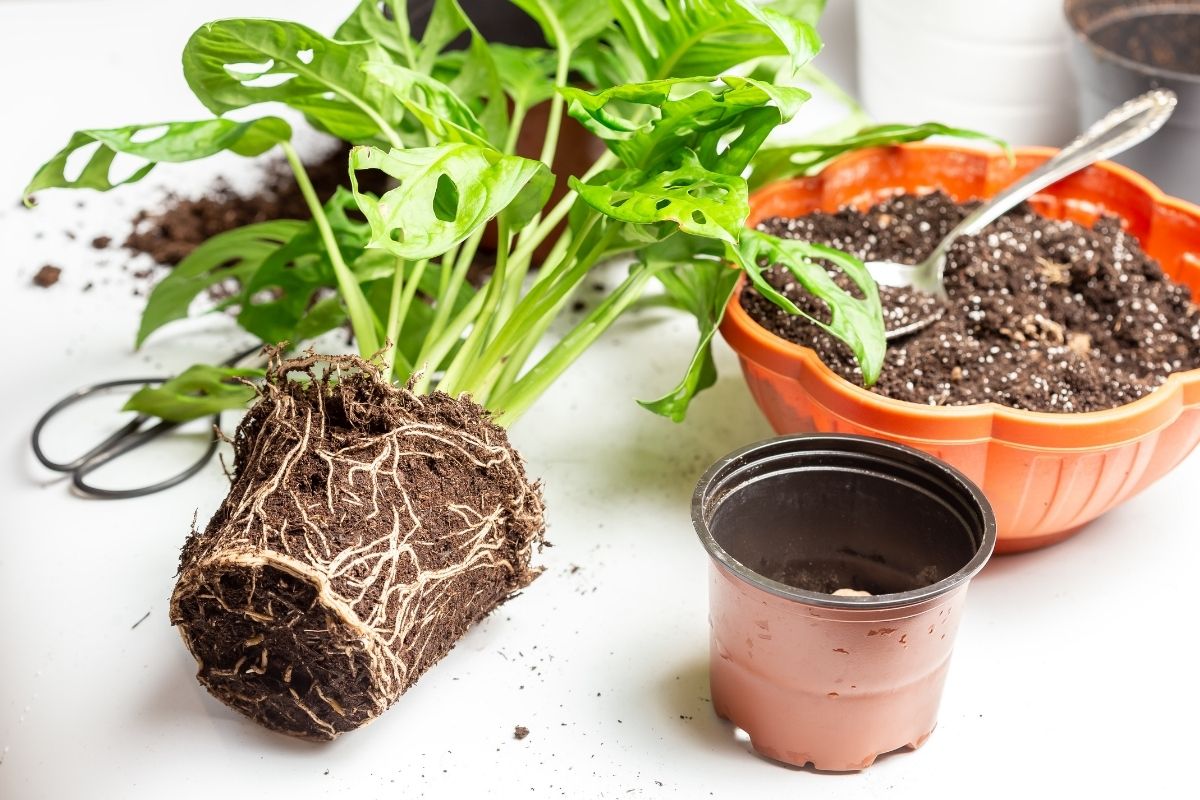
When there is a problem, there is usually always a solution. You can always save a Monstera at the early stages of root rot by removing the plant’s roots and taking it out from the contaminated soil. You can also prevent Monstera root rot in the future by following these steps.
You will first need to assess the plant and determine the stage of the Monstera stem rot. For severe cases of rotting, you will need to remove all the soil and discolored roots, then repot your Monstera deliciosa entirely. Unfortunately, if all the roots are completely black and mushy, then it cannot be saved.
What you’ll need
- gardening scissors, knife or pruning shears
- a new clean pot
- new potting mix
- white vinegar
- fungicide
- bleach or rubbing alcohol for sterilization
- gloves
What you’ll need to do
- Disinfect your pot. If you are not planning to transplant your plant to another pot, disinfect the old one using a bleach solution. Gently take the plant out of the pot and cover the roots with a plastic bag. Use a 10% bleach solution to disinfect the pot, then clean it with pure water.
- Wash and cut all the damaged roots. You absolutely need to get rid of all the damaged roots & infected material to treat root rot. Sterilize a sharp knife and start to cut off all the mushy roots.
- Dry and disinfect roots. Leave the roots to dry up completely in the sun to prevent re-infection. It could take up to a few hours. After, make sure to disinfect the roots with fungicide. You can also use a diluted solution of hydrogen peroxide.
- Prune the damaged leaves. Get rid of all the infected leaves and stems, by cutting away and pruning any unhealthy leaves and yellow leaves.
- Repot your monstera in a new pot. You can either use your old pot (by sterilizing with vinegar first) or place your Monstera in a brand new pot, with fresh soil and potting mix. Make sure your pot has drainage holds and fill 1/3 of the pot with potting mix.
Your plant will adapt naturally to its new environment and grow healthier and stronger by the day. Place the plant in indirect bright light to prevent any fungal infections from happening again.
How to prevent root rot
Maintaining a healthy root system is the easiest way to prevent root rot in Monstera plants. You can do this by giving the plant’s roots space to reach for moisture without being trapped in it.
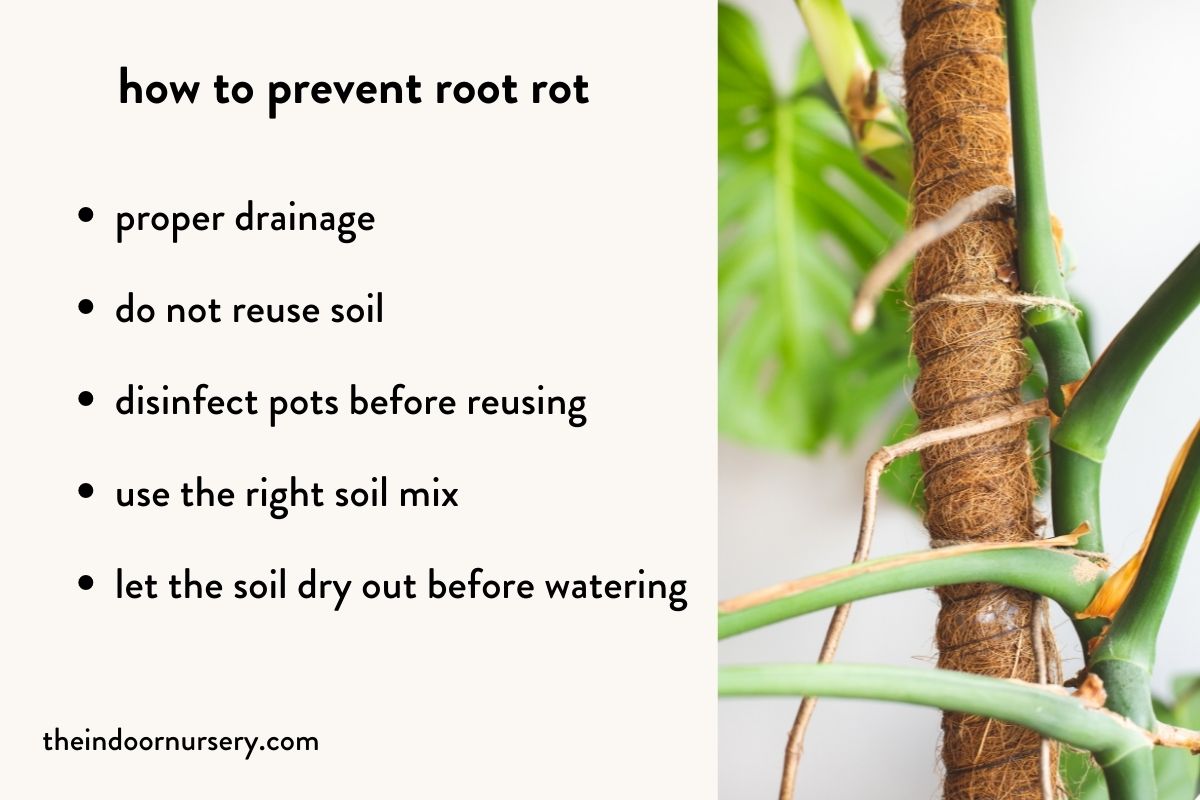
Here are the ways to avoid root rot:
- Proper drainage. This is an important one. make sure your pot has drainage holes, so the roots of your plant have room to breathe. A pot without drainage holes is a big no-no. If you have drainage holes, but don’t see water coming out of the bottom—get a pot with more drainage holes.
- Do not reuse soil. If you have already diagnosed your Monstera with root rot, then you will not want to let your plant sit in the same infected soil. You can change the soil of your Monstera plant every year and a half with better soil, to prevent re-infection.
- Disinfect pots before reusing. If you are dealing with a fungal problem, you will want to disinfect the pots with vinegar or alcohol to kill all the bacteria. let it dry in the sun after to make sure all the harmful bacteria is gone. You can add neem oil to your soil for extra protection.
- Use the right soil mix. Monstera plants like a potting mix that drains well and holds moisture well. You can add an organic mix of moss, or coco coir or other organic matter to ensure the soil mix is perfect for your Monstera.
- Let the soil dry out before watering. You can check that your soil is dry enough by checking the first 2 inches of the top part of the soil. If the soil is wet and damp, wait a couple more days for it to dry out before re-watering.
The bottom line
Taking care of your Monstera plant beforehand is the most ideal way to prevent root rot. Just like us humans, we don’t need to wait until we are feeling really, really sick to start eating healthy or taking care of ourselves.
A final reminder to make sure to check the soil often to not overwater, and always pay attention to the color of the leaves. Make sure to give your plant enough indirect sunlight. Your Monstera leaves should be bright, verdant, shiny and growing during their growing season.
All of this will ensure that you have a very happy and thriving Monstera deliciosa plant, and that you will be a happy and confident indoor houseplant owner!
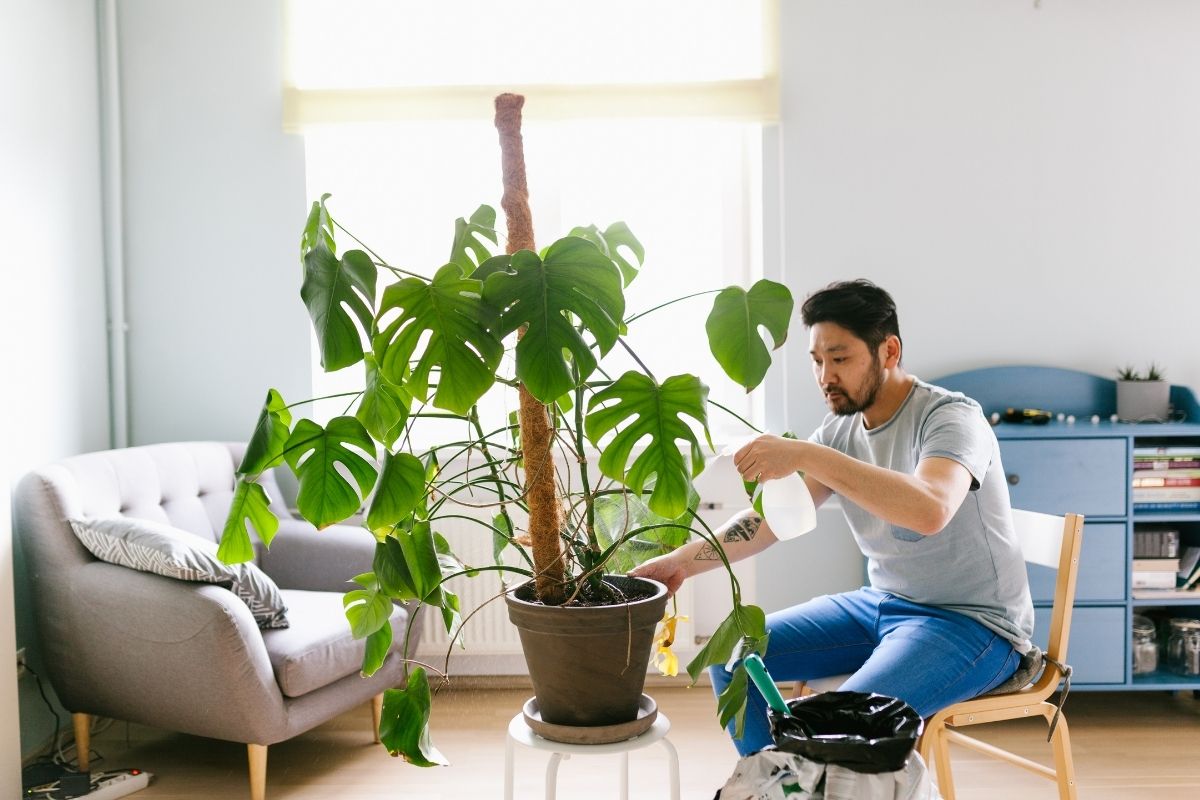
FAQs
Is it OK to place moss on top of the soil of my Monstera plant?
Yes, moss can help absorb and retain water & nutrients. You can also use a moss pole to help your Monstera plant grow and mimic its habitat in the wild. You will just want to make sure that the soil doesn’t become overly soggy.
My Monstera plant doesn’t have a lot of roots and some wrinkling at the leaf base; is this root rot?
If the roots are mushy or rotten, then this is root rot. Monstera leaves wrinkling is usually a sign that your plant is being underwatered, receiving a lack of nutrients, or in low humidity. It could also be that the roots do not have enough room, and that you need to move your plant into a bigger pot. It is recommended that you review the environment and houseplant care to get to the root of the problem.
I just saved a plant from root rot; should it root in water first before going back into soil?
No, you want the roots to completely dry out in the sun before planting it back into your pot. You will also want the soil to dry out or to repot it with a new potting soil mix.
Are red-ish roots on a monstera plant ok? Or is that root rot?
If your Monstera has root rot, it will be most easily identified through the leaves. Red-ish roots are normal on a Monstera plant, as long as they are not mushy or smelly roots. You may want to have someone knowledgeable about Monstera houseplants check the roots for you to be sure.
My Monstera plant easily snapped off/fell out of the pot, is that root rot?
Yes, this could be a sign or root rot, as it causes very weak roots that break or snap off easily. It could also be that your Monstera plant is not supported, and needs a good, water-retaining moss pole to support its growth and environment.
Is a drooping leaf sign of root rot?
Drooping leaves can be a sign of under-watering. Wilted or yellowish brown leaves are a more clear depiction of root rot. It is also normal for just a few of your Monstera leaves to be drooping or falloff, as this is a sign the plant is replacing them with new, healthy leaves.
More About Monsteras
- How Often To Water Monstera Plants
- Monstera Adansonii Care Guide
- Monstera Deliciosa Care: How To Care Of Monstera Plants
- Save Your Overwatered Monstera In 4 Steps (And How Not To Do It Again)
- Scale On Monstera: What To Do And How To Save It
- Best Soil For Monstera Plants (DIY Recipe + Store-Bought Options)
- Best fertilizer for Monstera plants for gorgeous leaves
- Tags:
- monstera
- root rot
- tropical plants

